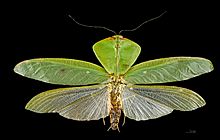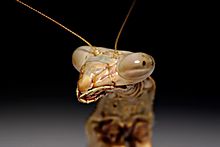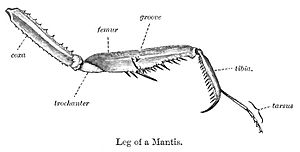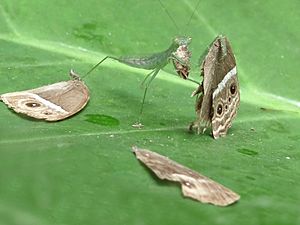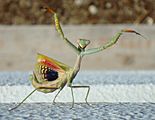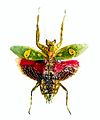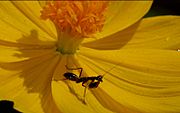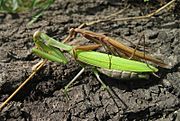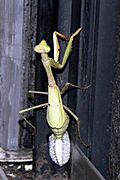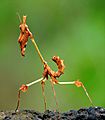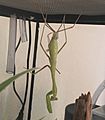Mantis facts for kids
Quick facts for kids MantodeaTemporal range: Cretaceous - Recent
|
|
|---|---|
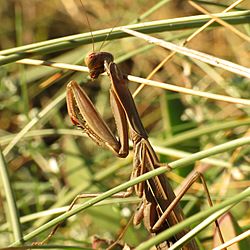 |
|
| European manits (Mantis religiosa) | |
| Scientific classification | |
| Kingdom: | |
| Phylum: | |
| Class: | |
| Subclass: | |
| Infraclass: | |
| Superorder: | |
| Order: |
Mantodea
|
A Mantis (order Mantodea) is a type of insect. They are usually known as praying mantids because of their prayer-like stance.
The group contains about 2,300 species. They occur in temperate and tropical habitats. Most are in are in the family Mantidae, and are called Mantids.
In Europe, the name "praying mantis" refers to only a single species, Mantis religiosa. They are sometimes confused with phasmids (stick insects).
The closest relatives of mantids are the order Blattodea (cockroaches and termites), and these two groups together are ranked as the Superorder Dictyoptera.
Contents
Life habit
Mantids are notable for their hunting abilities. They are predators, and their diet usually consists of living insects, including flies and aphids. Larger species have been known to prey on small lizards, frogs, birds, snakes, and even rodents.
Most mantids are ambush predators, waiting for prey to stray too near. The mantis then lashes out at remarkable speed. Some ground and bark species, however, pursue their prey rather quickly.
Prey are caught and held securely with grasping, spiked forelegs ('raptorial' legs); the first thoracic segment, the prothorax, is commonly elongated and flexibly articulated, allowing for greater range of movement of the front limbs while the remainder of the body remains more or less still.
The movement of the head is also remarkably flexible. It gives nearly 300 degrees of movement in some species. This allows for a great range of vision (their compound eyes have a large binocular field of vision) without having to move the rest of the body. As their hunting relies heavily on vision, they are mainly diurnal, but many species fly at night, when there is less chance of being taken by birds.
Mantids are masters of camouflage and most species make use of protective colouration to blend in with the foliage or substrate. This helps to avoid predators themselves, and to better snare their victims. They not only blend with the foliage, but mimic it, appearing as either living or withered leaves, sticks, tree bark, blades of grass, flowers, or even stones. Some species in Africa and Australia are able to turn black after a molt following a fire in the region to blend in with the fire ravaged landscape (fire melanism).
Mantids bite, but have no venom, and are not dangerous to humans. They are not chemically protected; nearly any large predatory animal will eat a mantis if it is able to detect it. Mantids are generally quite aggressive towards one another, in fact, and most species are readily cannibalistic when given the opportunity).
Biology
Anatomy
Mantises have large, triangular heads with a beak-like snout and mandibles. They have two bulbous compound eyes, three small simple eyes, and a pair of antennae. The articulation of the neck is also remarkably flexible; some species of mantis can rotate their heads nearly 180°. The mantis thorax consists of a prothorax, a mesothorax, and a metathorax. In all species apart from the genus Mantoida, the prothorax, which bears the head and forelegs, is much longer than the other two thoracic segments. The prothorax is also flexibly articulated, allowing for a wide range of movements of the head and fore limbs while the remainder of the body remains more or less immobile.
Mantises have two spiked, grasping forelegs ("raptorial legs") in which prey items are caught and held securely. In most insect legs, including the posterior four legs of a mantis, the coxa and trochanter combine as an inconspicuous base of the leg; in the raptorial legs, however, the coxa and trochanter combine to form a segment about as long as the femur, which is a spiky part of the grasping apparatus (see illustration). Located at the base of the femur is a set of discoidal spines, usually four in number, but ranging from none to as many as five depending on the species. These spines are preceded by a number of tooth-like tubercles, which, along with a similar series of tubercles along the tibia and the apical claw near its tip, give the foreleg of the mantis its grasp on its prey. The foreleg ends in a delicate tarsus used as a walking appendage, made of four or five segments and ending in a two-toed claw with no arolium.
Mantises can be loosely categorized as being macropterous (long-winged), brachypterous (short-winged), micropterous (vestigial-winged), or apterous (wingless). If not wingless, a mantis has two sets of wings: the outer wings, or tegmina, are usually narrow and leathery. They function as camouflage and as a shield for the hind wings, which are clearer and more delicate. The abdomen of all mantises consists of 10 tergites, with a corresponding set of nine sternites visible in males and seven visible in females. The abdomen tends to be slimmer in males than females, but ends in a pair of cerci in both sexes.
Vision
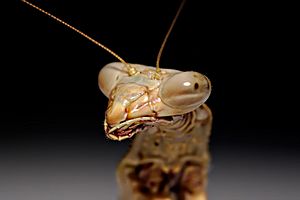
Mantises have stereo vision. They locate their prey by sight; their compound eyes contain up to 10,000 ommatidia. A small area at the front called the fovea has greater visual acuity than the rest of the eye, and can produce the high resolution necessary to examine potential prey. The peripheral ommatidia are concerned with perceiving motion; when a moving object is noticed, the head is rapidly rotated to bring the object into the visual field of the fovea. Further motions of the prey are then tracked by movements of the mantis's head so as to keep the image centered on the fovea. The eyes are widely spaced and laterally situated, affording a wide binocular field of vision and precise stereoscopic vision at close range. The dark spot on each eye that moves as it rotates its head is a pseudopupil. This occurs because the ommatidia that are viewed "head-on" absorb the incident light, while those to the side reflect it.
As their hunting relies heavily on vision, mantises are primarily diurnal. Many species, however, fly at night, and then may be attracted to artificial lights. Mantises in the family Liturgusidae collected at night have been shown to be predominately males; this is probably true for most mantises. Nocturnal flight is especially important to males in locating less-mobile females by detecting their pheromones. Flying at night exposes mantises to fewer bird predators than diurnal flight would. Many mantises also have an auditory thoracic organ that helps them avoid bats by detecting their echolocation calls and responding evasively.
Diet and predation
Mantises are generalist predators of arthropods. The majority of mantises are ambush predators that only feed upon live prey within their reach. They either camouflage themselves and remain stationary, waiting for prey to approach, or stalk their prey with slow, stealthy movements. Larger mantises sometimes eat smaller individuals of their own species, as well as small vertebrates such as lizards, frogs, and small birds.
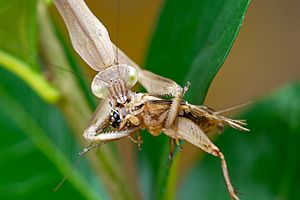
Most mantises stalk tempting prey if it strays close enough, and will go further when they are especially hungry. Once within reach, mantises strike rapidly to grasp the prey with their spiked raptorial forelegs. Some ground and bark species pursue their prey in a more active way. For example, members of a few genera such as the ground mantises, Entella, Ligaria, and Ligariella run over dry ground seeking prey, much as tiger beetles do.
The fore gut of some species extends the whole length of the insect and can be used to store prey for digestion later. This may be advantageous in an insect that feeds intermittently. Chinese mantises live longer, grow faster, and produce more young when they are able to eat pollen.
Antipredator adaptations
Mantises are preyed on by vertebrates such as frogs, lizards, and birds, and by invertebrates such as spiders, large species of hornets, and ants. Some hunting wasps, such as some species of Tachytes also paralyse some species of mantis to feed their young. Generally, mantises protect themselves by camouflage, most species being cryptically colored to resemble foliage or other backgrounds, both to avoid predators and to better snare their prey. Those that live on uniformly colored surfaces such as bare earth or tree bark are dorsoventrally flattened so as to eliminate shadows that might reveal their presence. The species from different families called flower mantises are aggressive mimics: they resemble flowers convincingly enough to attract prey that come to collect pollen and nectar. Some species in Africa and Australia are able to turn black after a molt towards the end of the dry season; at this time of year, bush fires occur and this coloration enables them to blend in with the fire-ravaged landscape (fire melanism).

When directly threatened, many mantis species stand tall and spread their forelegs, with their wings fanning out wide. The fanning of the wings makes the mantis seem larger and more threatening, with some species enhancing this effect with bright colors and patterns on their hind wings and inner surfaces of their front legs. If harassment persists, a mantis may strike with its forelegs and attempt to pinch or bite. As part of the bluffing (deimatic) threat display, some species may also produce a hissing sound by expelling air from the abdominal spiracles. Mantises lack chemical protection, so their displays are largely bluff. When flying at night, at least some mantises are able to detect the echolocation sounds produced by bats; when the frequency begins to increase rapidly, indicating an approaching bat, they stop flying horizontally and begin a descending spiral toward the safety of the ground, often preceded by an aerial loop or spin. If caught, they may slash captors with their raptorial legs.
Mantises, like stick insects, show rocking behavior in which the insect makes rhythmic, repetitive side-to-side movements. Functions proposed for this behavior include the enhancement of crypsis by means of the resemblance to vegetation moving in the wind. However, the repetitive swaying movements may be most important in allowing the insects to discriminate objects from the background by their relative movement, a visual mechanism typical of animals with simpler sight systems. Rocking movements by these generally sedentary insects may replace flying or running as a source of relative motion of objects in the visual field. As ants may be predators of mantises, genera such as Loxomantis, Orthodera, and Statilia, like many other arthropods, avoid attacking them. Exploiting this behavior, a variety of arthropods, including some early-instar mantises, mimic ants to evade their predators.
-
Leaf mimicry: Choeradodis has leaf-like fore wings and a widened green thorax.
-
Adult female Iris oratoria performs a bluffing threat display, rearing back with the forelegs and wings spread and mouth opened.
-
The jeweled flower mantis, Creobroter gemmatus: the brightly colored wings are opened suddenly in a deimatic display to startle predators.
-
Some mantis nymphs mimic ants to avoid predators.
Reproduction and life history
The mating season in temperate climates typically takes place in autumn, while in tropical areas, mating can occur at any time of the year.
The female lays between 10 and 400 eggs, depending on the species. Eggs are typically deposited in a froth mass-produced by glands in the abdomen. This froth hardens, creating a protective capsule, which together with the egg mass is called an ootheca. Depending on the species, the ootheca can be attached to a flat surface, wrapped around a plant, or even deposited in the ground. Despite the versatility and durability of the eggs, they are often preyed on, especially by several species of parasitoid wasps. In a few species, mostly ground and bark mantises in the family Tarachodidae, the mother guards the eggs. The cryptic Tarachodes maurus positions herself on bark with her abdomen covering her egg capsule, ambushing passing prey and moving very little until the eggs hatch.
As in closely related insect groups in the superorder Dictyoptera, mantises go through three life stages: egg, nymph, and adult (mantises are among the hemimetabolous insects). For smaller species, the eggs may hatch in 3–4 weeks as opposed to 4–6 weeks for larger species. The nymphs may be colored differently from the adult, and the early stages are often mimics of ants. A mantis nymph grows bigger as it molts its exoskeleton. Molting can happen five to 10 times before the adult stage is reached, depending on the species. After the final molt, most species have wings, though some species remain wingless or brachypterous ("short-winged"), particularly in the female sex. The lifespan of a mantis depends on the species; smaller ones may live 4–8 weeks, while larger species may live 4–6 months.
-
Mantis religiosa mating (brown male, green female)
-
Stagmomantis carolina laying ootheca
As pets
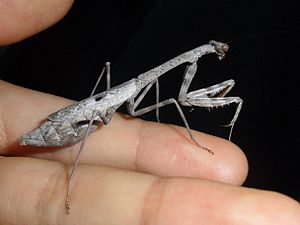
Mantises are among the insects most widely kept as pets. Because the lifespan of a mantis is only about a year, people who want to keep mantises often breed them. In 2013 at least 31 species were kept and bred in the United Kingdom, the Netherlands, and the United States. In 1996 at least 50 species were known to be kept in captivity by members of the Mantis Study Group. The Independent described the "giant Asian praying mantis" as "part stick insect with a touch of Buddhist monk", and stated that they needed a vivarium around 30 cm (12 in) on each side. The Daily South argued that a pet insect was no weirder than a pet rat or ferret, and that while a pet mantis was unusual, it would not "bark, shed, [or] need shots or a litter box".
Images for kids
-
Bronze ink brush rest in the shape of a mantis, Edo period, Japan, c. 1800
-
In Island, Aldous Huxley reflected on death as a pair of Gongylus gongylodes mated.
-
Grandmasters of the Shaolin Temple, Shi DeRu and Shi DeYang, demonstrating the Southern Praying Mantis style of martial art
See also
 In Spanish: Mantodea para niños
In Spanish: Mantodea para niños


